How
to reduce the cost of books is the concern of each of our publishing workers.
As Chinese printers,
should be proficient in plate making, printing technology, book printing cost standards,
understand paper specifications and performance and the production capacity of
relevant printing plants. In the printing work, according to the production
capacity of the printing plant, the plate making and printing process and the
selection of paper materials should be arranged reasonably to reduce the cost
of books.

Every
time a book is made, the overall design needs to be carried out by the
designer. The designer must design according to the content, nature, total
number of graphics and text, and readers. The cost of books is an important
factor in the competition in the book market. Now let’s talk about how to reduce
the cost of books from the perspective of pre-press printing.
1.
Paper opening
If
the format selection is unreasonable, the margins will increase and the
effective use area of paper will decrease. Books with more short lines, such as
a collection of poems in horizontal rows, use a 32-format book, with a lot of
blanks in the cut and order, and use more paper. If you use a long and narrow
36 format, you can save paper. If the format is too small, the number of folds
and the loss of smooth edge materials will also be greater. In order to
facilitate printing, try to avoid or use less irregular format, which can
reduce printing costs.
2. Paper
materials
Paper
materials account for a large proportion of book costs, accounting for more
than 40%. Therefore, the rational selection of paper materials is an important
aspect of reducing the cost of books.
Ordinary
books, such as compendiums, learning materials, literary and artistic readings,
etc., paperbacks can use 52g/m2 (hereinafter referred to as 52g) letterpress
paper, and hardcovers can choose 60g or 70g offset paper.
Songs
and children's books can use 60g paper in monochrome, and 80g offset paper in
color.
Textbooks
generally use 49-60g letterpress paper; for reference books, paperback books
use 52g letterpress paper, hardcover books can choose 40g dictionary paper, and
general technical standards can use 80�?20g
offset paper.
To
Pictures
and picture albums, generally 80�?20g
offset paper or 100�?28g
coated paper; can choose offset paper or coated paper and weight according to
the degree of fine printing of the album, format. New Year pictures and posters
generally use 50-80g single-sided offset paper, comics use 52-50g relief paper,
and high-end exquisite small pictures use 256g glass cards.
Magazine
generally uses 52-80g paper, monochrome generally uses 60g writing paper or
offset paper, and color generally uses 80g double-print paper.
Covers,
inserts and interleaf pages of books and magazines: generally use 100-150g
paper for covers up to 200 pages, 120-180g paper for more than 200 pages;
80-150g paper for interleafes; interleaf pages are generally between 80-150g
depending on the thickness of the book Optional.
For
the same type of paper, the heavier the gram, the higher the price. The weight
of the text paper increases, and the thickness of the spine also thickens.
Sometimes it is necessary to adjust the gram weight and opening number of the
cover paper, which will produce a series of ties. Often increases the cost of
paper.
Carefully
select paper materials, but do not cut corners. For example, printing a finer
screen version with ordinary paper will blur the layout, all ineffective, and
cause waste. Another example is that newsprint can be used for ordinary
reading, while newsprint that is easy to weather cannot be used for books that
need to be stored for a long time.
3. The number
of pages of the book
When
composing plates, try to avoid zero pages. Because in addition to the main
text, a book has other parts such as four envelopes, title page, preface, table
of contents, copyright pages, etc., and each part may use different paper, so
the total number of pages of the same paper type is made up to 4. Multiples of
is not difficult.
4.
Binding form and layout design
Commonly
used book binding forms include saddle stitching, flat stitching, stitch
binding, perfect binding, etc. Saddle stitching, stitch stitching and perfect
binding can be designed to make the center spread smaller. If it is a
flat-stitched form, the center of the center spread should be relatively large,
because the stitching of a flat-stitched book takes about 5mm.
Contact
us for more information about the cost of Chinese printing. We will guide
you how to reduce your printing cost.
 Email:[email protected]
Email:[email protected] Tel/WhatsApp:+86 13580851182
Tel/WhatsApp:+86 13580851182














